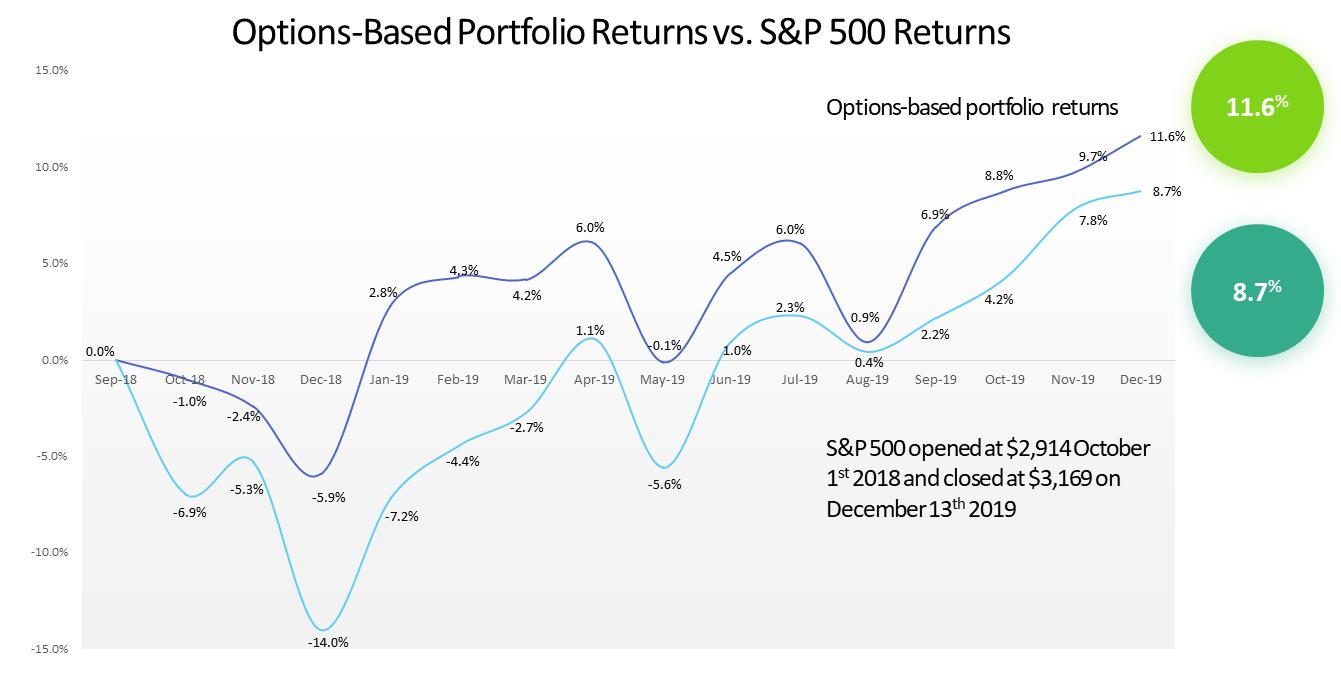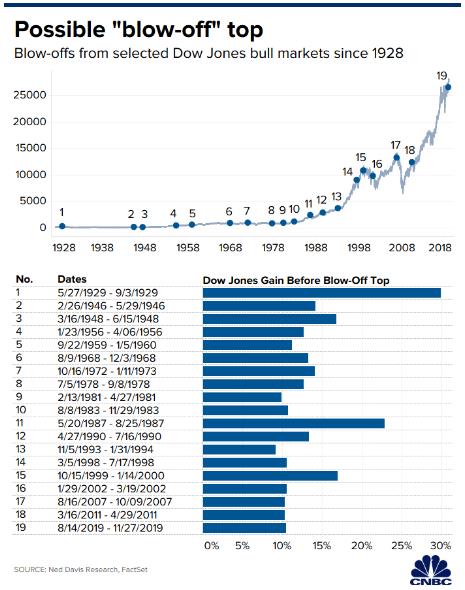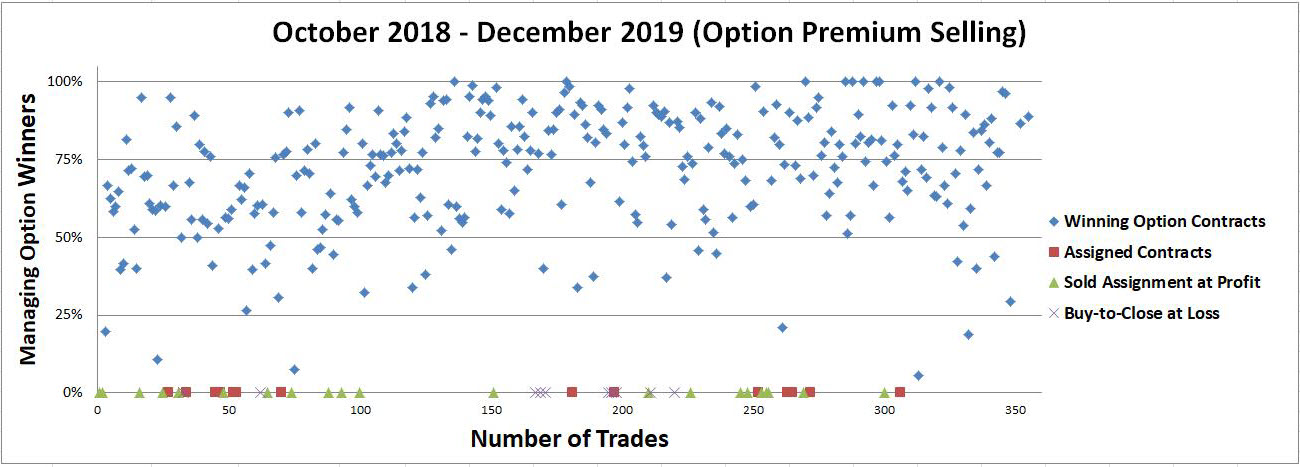Impeachment proceedings, U.S.-China trade war, Federal Reserve actions, etc., dominate the headlines and move markets in lock-step. The broader indices are at all-time highs and continue to set new high after new high despite the aforementioned variables. The markets have been on a steady rise for months without much resistance, and overall volatility remains low, indicating that market participants have become overly confident and complacent. The S&P 500 has had a banner year in 2019, posting a year-to-date return of over 25% through mid-December. A “blow-off” rally may be underway at this market juncture, and locking-in portfolio gains while mitigating risk is prudent. An options-based portfolio can offer a superior method to constantly locking-in gains while mitigating risk in these frothy market conditions. Over the previous 15 months through the bear market of Q4 2018 and the bull market of 2019, an options-based portfolio has returned 11.6% compared to the S&P 500 return of 8.7%. These returns have been accomplished with an 87% win rate while having the flexibility to hold ~50% of my portfolio in cash. An options portfolio enables optimal risk mitigation and realization of profits on a continual basis, especially important during market euphoria conditions.
Protecting Market Gains
An options-based approach is much like an insurance company where you sell insurance policies and collect premium income at a level that maximizes a statistical edge to your benefit. This strategy mitigates risk and circumvents drastic market moves. Selling options and collecting premium income in a high-probability manner generates consistent income for steady portfolio appreciation in both bear and bull market conditions. This is all done without predicting which way the market will move. Primarily sticking with dividend-paying large-cap stocks across a diversity of tickers that are liquid in the options market is a great way to generate superior returns with less volatility over the long-term.
Over the past ~15 months, 349 trades have been made with a win rate of 87% and a premium capture of 58% across 70 different tickers. When stacked up against the S&P 500, the options strategy generated a return of 11.6% compared to the S&P 500 index which returned 8.7% over the same period. Options are a bet on where stocks won’t go, not where they will go, where high probability options trading thrives in both bear and bull markets (Figures 1 and 2).

Figure 1 – options-based portfolio returns overlaid with the S&P 500 returns over the same period. Options based portfolio return (11.6%) in comparison to the S&P 500 return (8.7%) over the past ~15 months through both bear and bull market conditions. S&P 500 closed at $2,914 on September 30th, 2018 and closed at $3,169 on December 13th, 2019

Figure 2 – options-based portfolio - comprehensive metrics over the past ~15 months. The strategy has generated winning trades 87% of the time, capturing 58% of the premium income across 70 different tickers symbols
Euphoric Market Conditions
The broader indices have marched higher and higher to set new highs on what seems like a daily basis. Stocks have been on fire in November and through-December due to easier monetary policy by the Federal Reserve and expectations that China and the U.S. will reach a trade deal. A completed phase one deal was in fact, reached and propelled the markets to even higher levels. The Federal Reserve cut rates twice since August and has signaled it will keep them at current levels for 2020.
Briefly, the indices had a poor start to December, which halted this euphoric rally that has historically marked the end of past bull markets, a so-called blow-off top. Between mid-August and late November, the Dow Jones was up 10.5% in a 74-day sprint that seemed to be immune from negative headlines. Per to Ned Davis Research, the Dow has posted a median gain of 13.4% during blow-off tops dating to 1901. The median rally length was 61 days, and the current rally continues to march on beyond this median (Figure 3).

Figure 3 – Data over the course of bull markets with blow-off rallies
Furthermore, the consensus strategist forecast for the S&P 500 for any given year typically falls in the 5% to 10% range. Right now, CNBC’s strategist survey shows a median predicted 2020 S&P 500 gain of 6.5% to 3375. The average forecast is up 5%, and the maximum target right now is 3450 by BTIG’s Julian Emmanuel, which would be about a 9% advance.
The short term prediction rarely comes to fruition over to the long-term average. Since 1928, the S&P has only shown a gain of between 5-10% 6 out of the 91 calendar years – suggesting the consensus forecast for a high-single-digit rise in 2020 has a 93% chance of being wrong.
A year ago, strategists as a group were looking for an 11% gain for 2019 – but the forecasts was likely as high as it was because stocks had already fallen sharply since October of last year – and the then-aggregate target of 2940 for the S&P was merely a call that the index would recover back to its prior record high.
An Options-Based Strategy Generates Alpha
“Alpha” (α) – A term used to describe a strategy's ability to beat the market. Alpha is also referred to as “excess return” or “abnormal rate of return,” eluting to the theory that markets are efficient. Thus there’s no systematic method to generate returns that beat the broader market’s returns. To illustrate this point, 92% of actively managed funds do not outperform their benchmark thus do not generate any alpha giving rise to the efficient market theory. Furthermore, over 26 years from 1983 – 2006, the Russell 3000 index had 39% of stocks that were unprofitable investments, 64% of stocks that underperformed the index and 25% of stocks were responsible for all the market’s gains. Effectively, there’s a 36% chance of picking a stock that will outperform the market, thus generating any alpha.
Those that subscribe to the efficient market hypothesis believe that there’s no edge or advantage when it comes to picking stocks. Thus, stock picking is a binary event and boils down to a 50/50 probability or simply chance. Everything that can be possibly known about a stock is known, and all the available information, technical analysis, and fundamental analysis is priced into the underlying stock price. The efficient market theory may be the Achilles heel of professional money managers’ performance and their inability to outperform their benchmarks. If the efficient market theory is correct, is stock picking a useless endeavor? If stock-picking boils down to chance, is there a strategy that places the statistical odds of success in one’s favor to consistently generate alpha?
The short answer is yes, an options-based approach! The only way to consistently and reliably profit from this even distribution and market behavior is via options trading. Options trading allows one to profit without predicting which way the stock will move. Options trading isn’t about whether or not the stock will move up or down; it’s about the probability of the stock not moving up or down more than a specified amount. Options allow your portfolio to generate smooth and consistent income month after month for steady portfolio appreciation. Running an option-based portfolio offers a superior risk profile relative to a stock-based portfolio while providing a statistical edge to optimize favorable trade outcomes. Options trading is a long-term game that requires discipline, patience, time, maximizing the number of trade occurrences and continuing to trade through all market conditions. Put simply; an options-based approach provides a margin of safety with a decreased risk profile while providing high-probability win rates. The basic building blocks of running an options-based portfolio includes appropriate position sizing, diversity of tickers (stocks and ETFs), diverse sector exposure, trading through all market environments, maximizing the number of trades, managing risk, options liquidity and taking profits early (Figures 1, 2 and 4).
Results
Empirical results demonstrate true alpha over the previous ~15 months through bull and bear market conditions, outperforming the index by a wide margin (Figures 1 and 2). An options-based approach provides long-term, high-probability win rates to generate consistent income while circumventing drastic market moves. Over the previous ~15 months through both bull and bear markets, my win rate percentage was 87% (304/349 – Figure 4). Over the same period, the options-based portfolio generated an 11.6% return relative to 8.7% for the S&P 500, outperforming the index by a wide margin (Figures 1, 2 and 4).

Figure 4 – Dot plot summarizing ~300 trades over the previous 12-month period
Conclusion
Impeachment proceedings, U.S.-China trade war, Federal Reserve actions, etc., dominate the headlines with the broader indices continuing to set new high after new high. Overall, volatility remains low, indicating that market participants have become overly confident and complacent. The S&P 500 has had a banner year in 2019, posting a year-to-date return of over 25% through mid-December. A “blow-off” rally may be underway at this market juncture, and locking-in portfolio gains while mitigating risk is prudent. An options-based portfolio can offer a superior method to constantly locking-in gains while mitigating risk in these frothy market conditions. Over the previous 15 months through the bear market of Q4 2018 and the bull market of 2019, an options-based portfolio has returned 11.6% compared to the S&P 500 return of 8.7%. These returns have been accomplished with an 87% win rate while having the flexibility to hold ~50% of my portfolio in cash. An options portfolio enables optimal risk mitigation and realization of profits on a continual basis, especially important during market euphoria conditions.
An options-based portfolio has allowed me to do something 92% of actively managed funds haven’t been able to accomplish, and that outperforms the broader index on a consistent basis despite the volatility in Q4 2018, May 2019, August 2019 and a euphoric bull market in Q4 2019. Selling options with a favorable risk profile and a high probability of success is the key. Options provide long-term durable high-probability win rates to generate consistent income while mitigating drastic market moves. Taken together, options trading is a long game that requires discipline, patience, time, maximizing the number of trade occurrences and continuing to trade through all market conditions with the probability of success in your favor.
Thanks for reading,
The INO.com Team
Disclosure: The author holds shares in AAL, GE, KSS, SLB, TRIP, USO and X. The author has no business relationship with any companies mentioned in this article. This article is not intended to be a recommendation to buy or sell any stock or ETF mentioned.
